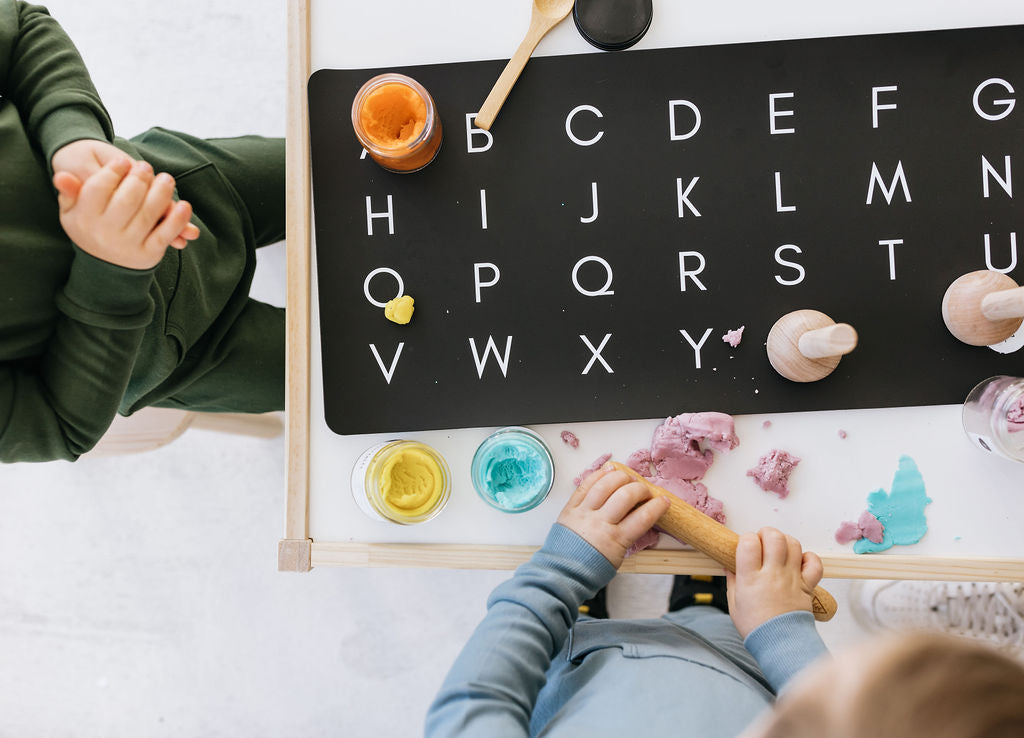

· By Jenna Mazzei
The Perfect Purposeful Toy
When it comes to play dough, the play opportunities are endless. One could even say that playdough is the perfect purposeful toy.
But what makes an activity purposeful? My short answer is that it has a purpose other than a distraction. However, the best purposeful toys successfully engage the child while also helping meet a developmental need and if you really think about it, play dough is the perfect example.

Not convinced that play dough is the perfect purposeful toy? As a Montessori teacher and mother, I’m sure I’ll convince you that, at least, Little Larch’s dough is!
So here’s the thing, children are naturally attracted to play dough because of its colours, textures and endless opportunities for creative play. Play dough is quite literally a constant invitation to play. However, this is just the tip of the iceberg. There is so much more below the surface that we don’t necessarily see or consider.
Let’s start with the basics.
Play Dough Prepares Children for Writing.
The squishing, rolling, pressing and forming of the play dough strengthens your child’s hands and wrists. As they continue to manipulate and create with the dough, they are consistently building and refining their fine-motor skills and pincer grasp which are essential preparations for future pencil and writing skills. On top of that, they are developing hand-eye coordination, logic and concentration skills through the creations they make.

Play Dough Encourages Independent Play
When a child can take part in an engaging activity without the help of an adult, they are not only building concentration skills but are building self-confidence. Building confidence in their abilities is a crucial skill that they will carry with them through the rest of their life. Setting up your child’s play dough in a way that allows them to be completely independent is the key. You can do this by teaching them how to open and close the bottle themselves or storing the play dough in an easy-to-open container.

Play Dough Inspires Creativity
Play dough is such an open-ended activity that your child can use it differently every day. One day they will be sculpting a flower, the next a pizza. Play dough is like an empty canvas, waiting to inspire your child’s next design.

Play Dough is The Perfect Motivator
Whether your child is learning shapes, colours, numbers or letters, play dough is the perfect motivator for learning activities! It is one of the most versatile learning tools out there and an absolute staple for all early childhood educators. The perfect example of this is setting your child up with one of Little Larch’s Letter Mats and having them create the letters out of play dough while superimposing them on the mat letters.

Okay, so that’s covers any play dough right? But why do I love Little Larch play dough in particular? I have a couple of reasons:
Not only do they produce a product that you can feel good about your child using but a dough that gives your child a multi-sensory experience.
Little Larch lightly scents their play dough with essential oils and this addition means that your child is now engaging their sense of smell, along with touch and sight. When your child engages multiple senses at once they are using different parts of their brain at the same time, resulting in a deeper learning experience and engagement session.
Since they choose to dye their dough with natural colours such as turmeric and spirulina, you can feel good about your child using it while knowing they are not coming into contact with harsh chemicals and dyes.

Amazing right?
Little Larch Play Dough is a staple in both my home and classroom. It’s an activity that my children and students use every single day. Knowing all of the benefits that come with this activity, I am thrilled that the children in my life get to take advantage of the perfect purposeful toy.
~ Written by Jenna Mazzei, Montessori Teacher & Little Larch Customer
Learn more at www.evolvemontessori.com
